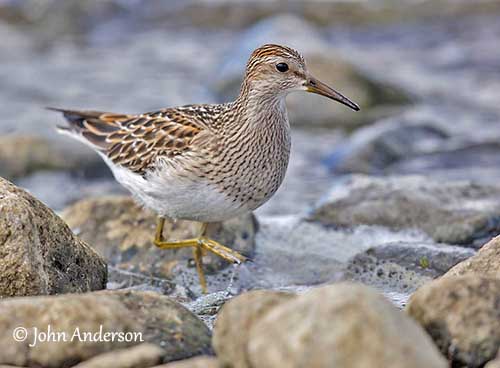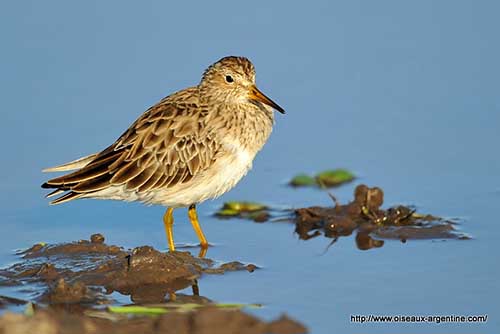
Fr: Bécasseau tacheté – Bécasseau à poitrine cendrée
Ang: Pectoral Sandpiper
All: Graubrust-Strandläufer
Esp: Correlimos Pectoral - Playero pectoral
Ita: Piro-piro pettorale
Nd: Gestreepte Strandloper
Sd: Tuvsnäppa
Photographers:
John Anderson
John Anderson Photo Galleries
Otto Plantema
Trips around the world
Philippe et Aline Wolfer
OISEAUX D’ARGENTINE
Text by Nicole Bouglouan
Sources:
HANDBOOK OF THE BIRDS OF THE WORLD Vol 3 by Josep del Hoyo-Andrew Elliott-Jordi Sargatal - Lynx Edicions - ISBN : 8487334202
SHOREBIRDS by Peter Hayman, John Marchant and Tony Prater – Christopher Helm – 1986 – ISBN: 0747014035
BirdLife International (BirdLife International)
What Bird-The ultimate Bird Guide (Mitchell Waite)
Department of Sustainability, Environment, Water, Population and Communities
Bird Web (Seattle Audubon Society)
All About Birds (Cornell Lab of Ornithology)
Wikipedia, the free encyclopaedia
Pectoral Sandpiper
Calidris malenotos
Charadriiformes Order – Scolopacidae Family
INTRODUCTION:
The Pectoral Sandpiper is included in the subfamily Calidrinae in the family Scolopacidae. This species frequents mainly grassy marshes and wet fields, but also coastal habitats.
During the displays, the male exhibits an inflatable air sac on its breast, giving the bird the English name “pectoral”.
This wader is a long-distance migrant. It leaves the breeding grounds in Siberia and North America to spend the winter in South America, as far as Tierra del Fuego, but also in Australia and New Zealand.

DESCRIPTION OF THE BIRD:
Biometrics:
Length: 18-23 cm
Wingspan: 37-45 cm
Weight: M: 45-126 g – F: 31-97 g
The adult male in breeding plumage has blackish-brown neck and breast heavily streaked buff, contrasting strongly with the white belly. There are some streaks on the flanks. Underwing-coverts and axillaries are white, slightly spotted greyish.
On the upperparts, mantle, scapulars and tertials are blackish-brown with variable chestnut and buff fringes, and white tips to feathers. The wing-coverts are paler, mostly grey-brown with paler fringes. The flight-feathers are blackish but the secondaries show narrow whitish tips. Centre of rump, uppertail-coverts and tail are blackish-brown, but the rump has narrow white sides and the outer rectrices are dull grey-brown.
On the head, the crown is dark brown with paler streaks. There is a whitish supercilium, often dull or absent. Lores and ear-coverts are brownish.
The bill is brownish-black with paler basal third. The eyes are dark brown. Legs and feet vary from dull greenish, brownish or yellowish.
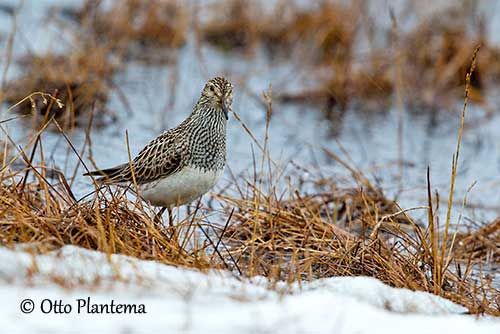
The female is usually duller and has paler breast. She is smaller than male.
The non-breeding adult has plainer and duller plumage with more brownish than chestnut upperparts and slightly more distinct supercilium.
The juvenile resembles breeding adult, with clear whitish supercilium, and upperpart’s feathers are fringed white, buff and chestnut, forming a white V across mantle and scapulars. The breast shows narrower streaking.
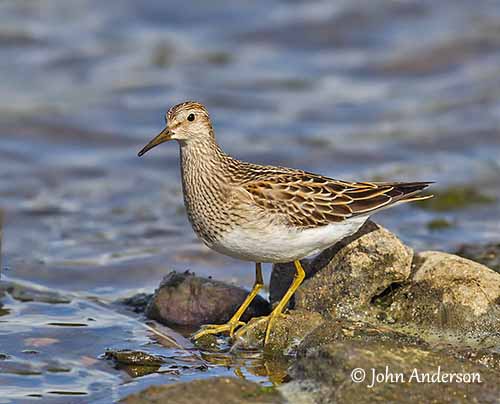
RANGE:
The Pectoral Sandpiper breeds in N Siberia, E through W and N Alaska and NC Canada to W Hudson Bay, and probably also on Yugorski Peninsula in N Russia.
This species winters in South America from Bolivia, Paraguay and S Brazil to C Chile and S Argentina (Tierra del Fuego). There are smaller wintering populations in SE Australia, Tasmania and New Zealand. It may be a rare winter visitor to Hawaiian Islands. It is a regular vagrant in Europe, in the Azores, the Canary Islands and Morocco.
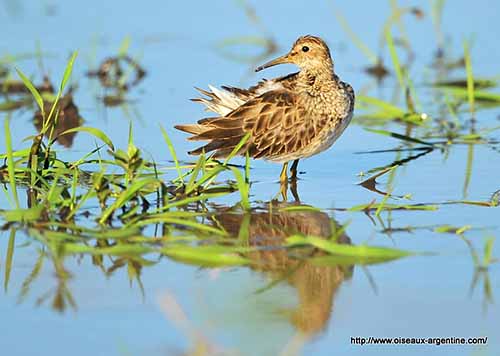
HABITAT:
The Pectoral Sandpiper breeds in wet and well-vegetated habitats in Arctic tundra with moss or Eriophorum (Cyperaceae), bogs of Polygonum (Polygonaceae) and water bodies lined with Arctic moss and lichens.
Outside the breeding season, it occurs in wet grassland and freshwater margins, both coastal and inland. It is also found in upland plateaux and puna zone at 3500-4500 metres of elevation where it frequents a variety of wetlands.
CALLS AND SONGS: SOUNDS BY XENO-CANTO
The Pectoral Sandpiper gives loud, harsh “churk” or “drrrip” in flight, often irregularly repeated.
During the song flight, the male utters loud hooting “oo-ah” usually 2-3 times/second. This sound is produced by the inflatable air-sac of the breast.
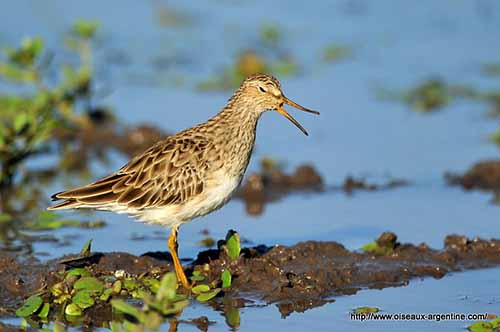
BEHAVIOUR IN THE WILD:
The Pectoral Sandpiper feeds mainly in drier vegetated patches and away from the water’s edge.
On the breeding grounds, it feeds on various insects including adults and larvae of Diptera, beetles and spiders. On migration, it takes larger insects such as grasshoppers and crickets. Outside the breeding season, it feeds on annelids, molluscs, crustaceans, spiders, insects, algae and seeds.
It forages among vegetation and in drier areas by fast, steady walking while pecking and probing in shallow, rapid movements. When disturbed, it stands upright with the neck extended, peering over the grass.
The Pectoral Sandpiper usually feeds in pairs or in small flocks, although it often gathers in large flocks at abundant food sources and suitable sites. Some individuals may defend a feeding territory.
The Pectoral Sandpiper performs courtship displays during a short period in June, and usually mates several times. The female often visits other males’ territories.
The displaying male exhibits a pendulous fat-filled sac concealed beneath the breast feathers. This sac distends the breast and enhances the strong contrast between the dark breast and the white belly.
The males arrive on the breeding grounds before the females, and establish the territories. The displays start as soon as the females arrive.
During the song flight, the male expands and contracts rhythmically the air sac, in time with the hooting calls. This display is used to attract the females.
The Pectoral Sandpiper is migratory, with Siberian and North American populations migrating to South America, following both Atlantic and Pacific coasts. Small numbers of Siberian birds winter in Australasia.
The males leave the breeding grounds in June, before the eggs hatch. The females leave in early August, and the juveniles follow them one month later.
The flight is fast and direct with rapid wingbeats.
REPRODUCTION OF THIS SPECEIS:
The laying occurs in June-July. The nest-site is a well-drained area covered with sedges and grasses.
The female builds the nest, sometimes on slightly elevated spot. The nest is a well-concealed scrape lined with grass and leaves. It is sometimes placed under low shrubs. She performs all the nesting duties, although the male may take part in brood defence, but usually, it leaves the area before the eggs hatch.

The female lays 4 eggs and incubates during 21-23 days. The chicks are precocial and leave the nest within hours of hatching. They feed themselves and remain with the female for at least 10 days. They fledge three weeks after hatching.
PROTECTION / THREATS / STATUS:
The Pectoral Sandpiper has wide range where it is relatively common. However, the chicks can be killed by skuas.
The global population is estimated to number 25,000/100,000 individuals. This population is suspected to be stable and currently, the Pectoral Sandpiper is evaluated as Least Concern.
